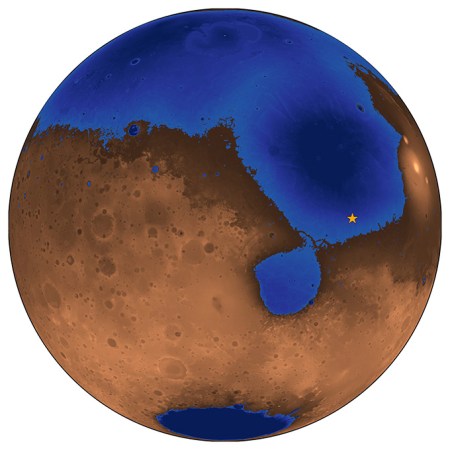Solid water helped paint the Red Mars and may have formed a wide coastline, discovering two new studies in the history of the planet.
Scientists have discovered an ancient beach in the northern hemisphere of Mars and identified a mineral containing water responsible for the pink color of the planet. The findings reveal details about the conditions in March when the planet for the last time contained large volumes of liquid water more than 3 billion years ago.
“Early March has historically been intended as” cold and dry “or” warm and wet, “says Alberto Fairén, an astrobiologist at the Center for Astrobiology in Madrid and Cornell University who was not involved in the work of cloud. “The two new studies, together, solve the second part of the equation: the early Mars was wet; it was never dry.”
The northern lowlands of Mars lie at a lower elevation than the rest of the planet, causing some scientists to suspect that the area had once been the land of a wide ocean. Zhurn, a Chinese Rover that landed on the edge of this region in 2021, used penetrating radar to the ground to investigate for marks of a past coastline buried deep under the surface.
Rover discovered a sloping long region of kilometers buried 10 to 35 meters underground that closely matches the slope of beaches on Earth, planetary scientist Michael Manga and colleagues report 24 February Proceedings of the National Academy of Sciences. Radar data suggests that the slope is made from pebble sediments to the sand.
Researchers considered the idea that the sand slope is a buried dune, like those found elsewhere on the Martian surface. But the detected features do not match the expected form of wind sand dunes, nor are they likely to be caused by rivers or lava leaks, scholars say. On the contrary, sediment deposits resemble deposits in the Earth’s coastline.
The findings do not yet confirm that Mars greeted full -sized oceans. But if the area represents an ancient coast, it can help scientists understand more about the planet’s past potential to wait for life. “The interface between water, rock and air is a beautiful environment in which life exists,” says Manga, from the University of California, Berkeley. “Some of the earliest lives on Earth were formed in those kinds of environments, in shallow water, along the short -term lines.”
Another study may imply in the state of March’s liquid water just before it disappears. The red color of the planet comes from a mineral containing water called ferrihidrite, which probably needs to form cold surface waters, reporters report 25 February The communications of nature.

“We were basically asking this long question as to why Mars is red, and many people probably realize that this is because of rust,” says Adam Valantinas, a planetary scientist at Brown University. “But there are many types of rust in the soil, many different minerals of these rust, and any specific aroma of this rust can tell you about environmental conditions when rust is formed.”
For years, scientists suspected that Mars took its red color from hematite, a form of iron or rust oxide, which contains no water and should therefore be formed after the planet lost its liquid water on the surface. But hematite does not absorb and reflect light in the same way as Martian powder, and discoveries of other minerals containing water on the surface of the LED Valantinas planet and its colleagues to ask if the hematite was really responsible for red colors.
The team measures the length of the light wave that the various laboratory samples of the minerals absorb and reflect and compare them with similar measurements of the March dust collected from orbit and space -based spacecraft. Researchers found that a mixture of a ferrihidrite part in two parts basalt, a volcanic rock, best matched the color of the Martian surface.
Ferrihidriti, a form of iron oxide containing water, would surely require cold, humid conditions to form in March, says Valantinas. In the soil, the mineral is somewhat unstable and will gradually turn into a more stable form of iron oxide, such as hematite. But cold temperatures and an acidic environment can slow that transition, stabilizing ferrihidritin until liquid water of the planet disappears.
“By combining the two studies, we can imagine an early March with abundant liquid water on the surface, to the point of forming seas or oceans, in a generally cold and very cold climate, similar in some sense with The beaches of the Arctic Ocean, ”says Fairén.
#Ancient #Mars #wet #cold #wet
Image Source : www.sciencenews.org